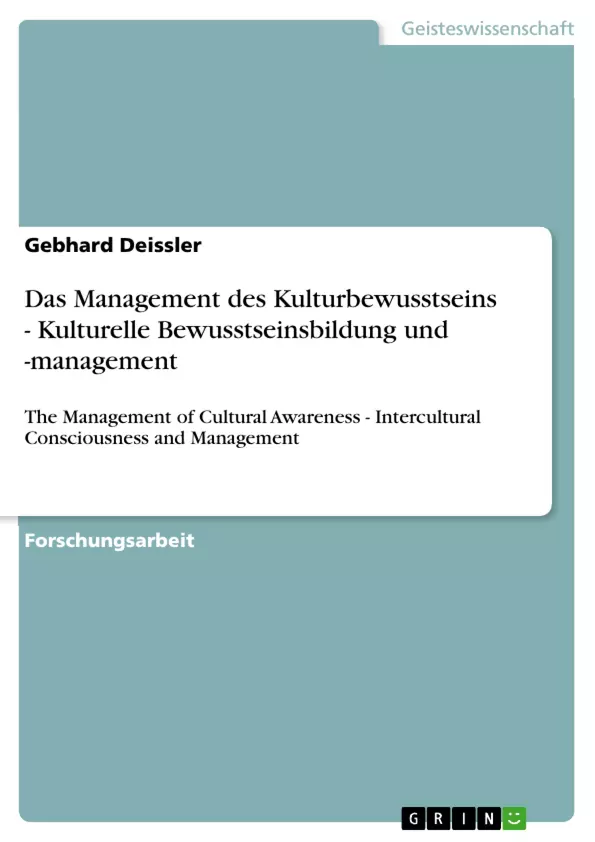Eine interkulturelle und interdisziplinäre Studie des interkulturellen und transkultuellen Bewusstseins. Die daraus resultierende verbesserte kulturelle und interkulturelle Bewusstheit kann sowohl die interkulturelle Bildung als auch das interkulturelle Management nachhaltig bereichern.
Inhaltsverzeichnis
- Teil/Part 1 ...7
- Die kulturelle Bewusstheit
- Das Dreiphasenmodell der interkulturellen Managemententwicklung ...7
- Kulturbewusstheit und Mosaikmetapher ...8
- Die Bewusstheit und der kosmische Computer …….9
- Bewusstheit und Psychoanalyse ...12
- Bewusstheit und interkulturelles Lernen ...13
- Die Bewusstheitserfordernis im interkulturellen Kontext ...14
- Kulturelle Bewusstheit, der Harvard Professor und das Weiße Haus ...15
- Bewusstheit. Das Dao der Kultur ...17
- Rationalismus und Grenzen der Bewusstheit ...18
- Neurophysiologie und Psychologie der kulturellen Bewusstheit...18
- Der kulturelle Autopilot ...20
- Quantenphysik und kulturelle Bewusstheit …..22
- Der metaphorische quantenkulturelle Effekt...22
- Die inter-transkulturelle Bewusstheitsintegration als Refugium ...24
- Kulturelle Bewusstheit und Universalkultur ...26
- 360° kulturelle Bewusstheit ...26
- Interkulturelles Bewusstheitsprozessmanagement ...27
- Part/Teil 2 ...30
- Enhancing Cultural Awareness
- A. The Intercultural Complementarity Principle...31
- B. The Intercultural Integration Principle: A Review of the Intercultural Paradigm …..37
- 1. The State of the Intercultural Art and Science: On Human Relativity in Intercultural Research ...38
- 2. Enhancing the Intercultural Art and Science: Sources, Models and the Achievement of Supreme Cultural Intelligence... 46
- C. Expanding Human Culture Consciousness...101
- 1. Physiological Aspects of Culture Consciousness and its Management ….102
- 2. The 'Culture-Cosmic Computer' ...111
- 3. The Cosmic Dimension of Global Diversity Management …..122
- 4. Reconciling Planetary Diversity through Transcultural Management ...129
- 5. A Third Millennium Global Civilisation Formula: Integrating the Relative and the Absolute...138
- 6. Metropolism - Cosmopolitanism – Cosmism …..154
- 7. Dimensions of ONE ...158
- 7.1 The Magic of the ONE: The One as the Regulator of Unity And Diversity ...158
- 7.2 Summum Unum: The Diversity Of Life ...173
- 7.3 Ut Unum Sint ...184
- Teil/Part 3 ...189
- Interkulturelles Management im Bewusstsein der Integrität der Schöpfung
- A. Die Integrität der Schöpfung ...190
- 1. Kulturelle Identität und Ethik im Kontext der Integrität der Schöpfung ...190
Zielsetzung und Themenschwerpunkte
Das Werk erforscht die Bedeutung und das Management von kulturellem Bewusstsein im interkulturellen Kontext. Der Fokus liegt auf der Entwicklung eines tieferen Verständnisses für kulturelle Unterschiede und deren Auswirkungen auf interkulturelle Kommunikation und Zusammenarbeit.
- Die Entwicklung eines Dreiphasenmodells der interkulturellen Managemententwicklung
- Die Bedeutung von Kulturbewusstheit und die Anwendung der Mosaikmetapher
- Die Rolle von Bewusstheit in der interkulturellen Kommunikation und dem interkulturellen Lernen
- Die Integration von interkulturellem Bewusstsein in verschiedenen Disziplinen wie Psychoanalyse, Quantenphysik und Neurophysiologie
- Die Förderung der interkulturellen Integration und die Entwicklung eines globalen Bewusstseins
Zusammenfassung der Kapitel
Teil 1: Die kulturelle Bewusstheit
Die ersten Kapitel untersuchen die Bedeutung von kulturellem Bewusstsein im interkulturellen Kontext. Der Autor präsentiert ein Dreiphasenmodell der interkulturellen Managemententwicklung und erklärt die Anwendung der Mosaikmetapher für die Analyse von Kulturen. Weitere Kapitel beleuchten die Rolle von Bewusstheit in verschiedenen Disziplinen wie Psychoanalyse und Neurophysiologie sowie die Herausforderungen und Möglichkeiten des interkulturellen Lernens.
Teil 2: Enhancing Cultural Awareness
Dieser Teil befasst sich mit dem Prinzip der interkulturellen Komplementarität und der interkulturellen Integration. Der Autor diskutiert den aktuellen Stand der interkulturellen Forschung und die Entwicklung eines umfassenden interkulturellen Paradigmas. Zudem werden die physiologischen Aspekte von Kulturbewusstsein und dessen Management sowie die Rolle des „Kultur-Kosmischen Computers“ im interkulturellen Kontext betrachtet.
Teil 3: Interkulturelles Management im Bewusstsein der Integrität der Schöpfung
Der dritte Teil konzentriert sich auf die Bedeutung von Kulturbewusstsein im Kontext der Integrität der Schöpfung. Der Autor befasst sich mit kultureller Identität und Ethik sowie der Rolle von interkulturellem Management im Schutz der natürlichen Welt.
Schlüsselwörter
Kulturelles Bewusstsein, Interkulturelles Management, Transkulturelles Management, Kulturelle Unterschiede, Interkulturelle Kommunikation, Interkulturelles Lernen, Psychoanalyse, Quantenphysik, Neurophysiologie, Globale Diversität, Integrität der Schöpfung.
- Quote paper
- D.E.A./UNIV. PARIS I Gebhard Deissler (Author), 2012, Das Management des Kulturbewusstseins - Kulturelle Bewusstseinsbildung und -management, Munich, GRIN Verlag, https://www.grin.com/document/190421



